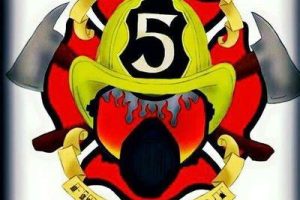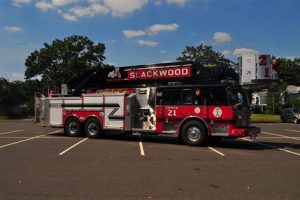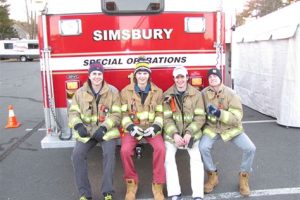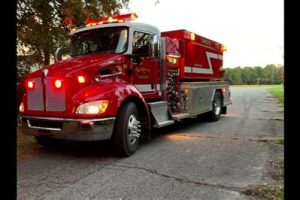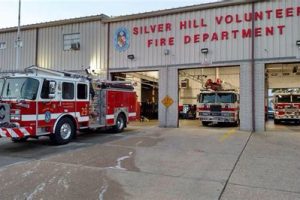Table of Contents
Discover the importance of Volunteer Fire Department Radios in emergency situations. These radios enable effective communication among firefighters, ensuring quick response times and coordinated efforts. Learn about the features, benefits, and advancements in radio technology that enhance the safety and efficiency of volunteer fire departments.
In the fast-paced world of emergency response, communication is key. When it comes to Volunteer Fire Departments, having reliable radios is crucial for saving lives and protecting communities. Whether it’s a blazing inferno or a medical emergency, these dedicated men and women rely on their radios to coordinate efforts, share critical information, and ensure the safety of both responders and victims. But what sets these radios apart from the ones we use in our daily lives? How do they enable firefighters to stay connected in the face of danger? Let’s dive into the world of Volunteer Fire Department radios and discover the lifeline that keeps these brave individuals connected, even in the most challenging circumstances.
Introduction
Volunteer fire departments play a crucial role in providing emergency services to communities across the country. These dedicated individuals selflessly give their time and effort to ensure the safety and well-being of their fellow citizens. One of the key tools that aid these brave volunteers in their duties are radios specifically designed for volunteer fire departments. In this article, we will explore the importance of these radios and how they enhance the effectiveness of these selfless firefighters.
Reliable Communication
The Backbone of Operations
Effective communication is the backbone of any successful operation, and firefighting is no exception. Volunteer fire department radios provide reliable communication channels between team members during emergencies. These radios enable firefighters to relay critical information, coordinate their efforts, and request additional resources when needed. The dependability of these radios ensures that every member of the team remains connected and informed, enhancing overall efficiency and response times.
Enhanced Safety
Keeping Firefighters Informed
Volunteer fire department radios keep firefighters informed about rapidly changing situations on the ground. Real-time updates regarding the fire’s behavior, structural integrity, and potential hazards are relayed through these radios, allowing firefighters to make informed decisions that prioritize their safety. This vital information empowers them to adapt their strategies and tactics accordingly, minimizing risks and ensuring the well-being of every team member.
Emergency Distress Signals
In the unfortunate event that a firefighter becomes trapped or injured while battling a fire, volunteer fire department radios serve as a lifeline. These radios often come equipped with emergency distress signals that can be activated to alert fellow team members of the dire situation. This feature allows for swift responses and immediate assistance, potentially saving lives in critical scenarios.
Seamless Coordination
Efficient Resource Allocation
Volunteer fire department radios facilitate seamless coordination between team members and incident commanders. By sharing information in real-time, these radios enable efficient resource allocation. Incident commanders can assess the situation accurately and direct personnel and equipment to where they are most needed, ensuring optimal response and effective firefighting efforts.
Interagency Communication
During large-scale emergencies or mutual aid situations, volunteer fire department radios also allow for effective communication between different agencies involved in the response. Fire departments, law enforcement, and medical services can exchange crucial information, coordinate efforts, and work together seamlessly. This interoperability enhances overall emergency management and ensures a coordinated response to protect lives and property.
Enhanced Efficiency
Quick Decision-Making
Timely decision-making is vital during firefighting operations, and volunteer fire department radios contribute to enhanced efficiency in this aspect. By providing instant communication, these radios enable firefighters to quickly communicate their observations, share situational updates, and seek guidance from incident commanders. This rapid exchange of information allows for agile decision-making, leading to more effective firefighting strategies.
Streamlined Incident Reporting
Accurate incident reporting is essential for post-incident analysis and future improvements. Volunteer fire department radios simplify this process by allowing firefighters to report critical information directly from the scene. They can relay details about fire behavior, injuries, structural conditions, and any other relevant observations. This streamlined incident reporting helps in documenting the incident accurately and aids in identifying areas for improvement in training and equipment.
Conclusion
Volunteer fire department radios are indispensable tools that enhance the capabilities and safety of these selfless firefighters. Reliable communication, enhanced safety features, seamless coordination, and improved efficiency are just a few of the benefits offered by these radios. As technology advances, it is crucial to continue equipping volunteer fire departments with the latest communication tools to ensure they can continue their invaluable service to their communities.
The Role of Volunteer Fire Department Radios in Ensuring Effective Emergency Response
Volunteer fire departments play a crucial role in ensuring the safety and well-being of communities across the nation. In this article, we delve into the importance of reliable communication systems, particularly radios, in empowering these dedicated men and women to execute their duties effectively during emergencies.
Enhancing Coordination and Collaboration
Volunteer fire department radios serve as an integral tool in fostering seamless coordination and collaboration among team members. By providing real-time communication capabilities, these radios enable firefighters to relay crucial information, update statuses, and request assistance efficiently, ultimately improving response times.
Immediate Communication with Dispatch Center
Equipped with reliable radio systems, volunteer firefighters can maintain constant communication with local dispatch centers. This direct line of communication enables them to relay critical details about the emergency situation promptly, ensuring appropriate resources are dispatched without delays, thus minimizing potential risks and damage.
Seamless Interoperability
Interoperability is paramount when multiple fire departments converge during large-scale emergencies. Volunteer fire department radios, often designed to comply with industry standards, support seamless communication between different agencies, fostering effective teamwork and information exchange to efficiently combat the incident at hand.
Safety Advancements and Emergency Updates
Volunteer fire department radios often come equipped with advanced safety features, such as built-in GPS tracking and emergency alert capabilities. These features assist in locating and safeguarding personnel during emergencies, while also providing crucial updates and instructions in real-time, enhancing overall situational awareness on the ground.
Handling Hazardous Environments
Volunteer firefighters often find themselves operating in hazardous environments where communication can be challenging. Dedicated radios with resilient construction, water resistance, and powerful transmission capabilities ensure that crucial fireground communications remain intact, even in the presence of extreme heat, smoke, or other adverse conditions.
Training and Skill Development
Volunteer fire department radios are not only integral during emergencies but also aid in training and skill development. Radios facilitate essential communication exercises, tactical simulations, and coordination drills, allowing firefighters to practice effective communication techniques while enhancing their overall firefighting proficiency.
Multi-Purpose Communications
In addition to emergency response efforts, volunteer fire department radios often serve various community-centric purposes. They enable volunteers to participate in community outreach programs, educational initiatives, and public safety campaigns, ensuring they remain engaged and connected with residents, ultimately promoting a safer and more resilient community.
Conclusion
With their role extending beyond emergencies, volunteer fire department radios are a critical communication lifeline for these dedicated individuals. By enhancing coordination, facilitating seamless interoperability, and providing real-time information, these radios empower volunteer firefighters to effectively serve and protect their communities in the face of adversity.
Point of View: Volunteer Fire Department Radios
In today’s fast-paced world, communication is vital for the smooth functioning of any organization. This rings particularly true for volunteer fire departments, where effective communication can mean the difference between saving lives and catastrophic outcomes. One crucial tool that these brave men and women rely on is their radios.
1. Reliability: The use of radios in volunteer fire departments ensures reliable communication during emergencies. These radios are specifically designed to operate in various challenging environments, including adverse weather conditions and remote locations. With their long battery life and durable construction, firefighters can trust that their radios will not fail them when they need them the most.
2. Instantaneous Communication: In emergency situations, every second counts. The use of radios allows for real-time communication among firefighters, enabling them to coordinate their efforts seamlessly. Whether they are at the scene of a fire or providing support from different locations, firefighters can relay critical information and receive updates instantly, enhancing their overall effectiveness.
3. Enhanced Safety: Volunteer firefighters often find themselves in high-risk situations where their safety is paramount. Radios play a crucial role in ensuring the safety of these brave individuals. They can quickly call for backup, report changing conditions, or request additional resources, all with the push of a button. This immediate line of communication significantly reduces response times and minimizes the potential risks faced by firefighters.
4. Efficient Resource Allocation: With limited resources at their disposal, volunteer fire departments must make every decision count. Radios enable efficient resource allocation by allowing firefighters to communicate their needs and share information about equipment availability. This helps in optimizing response strategies, ensuring that the right resources are deployed to the right places at the right time.
5. Training and Coordination: Volunteer firefighters often undergo extensive training to enhance their skills and knowledge. Radios play a vital role in facilitating this training process. They allow instructors to provide real-time guidance and instructions, simulating actual emergency scenarios. Additionally, radios help in coordinating drills and exercises, ensuring that firefighters are well-prepared to handle any situation that comes their way.
In conclusion, the use of radios in volunteer fire departments is an indispensable tool for effective communication and coordination. These devices provide reliability, instantaneous communication, enhanced safety, efficient resource allocation, and facilitate training and coordination. As volunteer firefighters continue to selflessly serve their communities, their radios will remain an essential lifeline, connecting them during the most critical moments.
Thank you for taking the time to visit our blog and learn more about Volunteer Fire Department Radios. As journalists, it is our duty to provide you with accurate and informative content that not only educates but also raises awareness about important topics. In this article, we have explored the significance of radios for volunteer fire departments, highlighting their crucial role in ensuring effective communication during emergencies.
First and foremost, it is essential to understand that communication plays a vital role in any emergency response situation. Volunteer fire departments often operate in rural areas or small communities, where reliable communication infrastructure may be lacking. This is where radios step in, serving as a lifeline for firefighters and other emergency personnel. With the help of these devices, they can quickly coordinate their efforts, call for backup, and request necessary resources.
The advantages of using radios for volunteer fire departments are numerous. Unlike cell phones, which may lose signal in remote areas or during natural disasters, radios offer a robust and reliable means of communication. They operate on dedicated frequencies, ensuring that transmissions are clear and interference-free. Additionally, radios are designed to withstand harsh conditions, including extreme temperatures, water, and impact, making them highly durable in the field. These features make radios indispensable tools for volunteer firefighters who often find themselves in challenging environments.
In conclusion, volunteer fire department radios are not just simple communication devices; they are lifelines that play a crucial role in emergency response. By providing reliable and efficient communication, these radios enable firefighters and emergency personnel to work together effectively, ensuring the safety of both themselves and the community they serve. As journalists, it is our hope that this article has shed light on the importance of these devices and the impact they have on saving lives. We encourage you to support your local volunteer fire departments and help them acquire the necessary resources, such as radios, to continue their invaluable service.
Thank you once again for joining us on this informative journey. We hope that you found this article enlightening and gained a deeper understanding of the vital role played by radios in volunteer fire departments. Stay tuned for more compelling content, as we continue to explore important topics that shape our communities.
.
People also ask about Volunteer Fire Department Radios:
What are the main features of Volunteer Fire Department Radios?
- Enhanced Durability: Volunteer Fire Department Radios are designed to withstand rugged conditions and are often built to military-grade standards, ensuring they can endure harsh environments.
- Long Battery Life: These radios are equipped with high-capacity batteries that provide extended usage time, allowing firefighters to stay connected for longer periods without worrying about running out of power.
- Wide Coverage Range: Volunteer Fire Department Radios utilize powerful transmitters and receivers, enabling communication over vast distances, even in remote areas with limited infrastructure.
- Emergency Alert Functions: These radios often come with dedicated emergency buttons that can be activated to transmit distress signals, ensuring rapid response and assistance in critical situations.
- Interoperability: Volunteer Fire Department Radios are designed to be compatible with various radio systems and frequencies used by different emergency services, facilitating seamless communication during joint operations.
How do Volunteer Fire Department Radios differ from regular consumer radios?
- Robust Construction: While consumer radios are typically designed for everyday use, Volunteer Fire Department Radios are built to withstand extreme conditions encountered in firefighting scenarios, such as heat, water, and impact.
- Advanced Features: Volunteer Fire Department Radios offer specialized features like noise cancellation, encryption capabilities, and priority channel allocation to ensure effective communication even in noisy or chaotic environments.
- Extended Range: These radios are capable of transmitting and receiving signals over long distances, allowing firefighters to maintain contact with their team members even in remote locations.
- Dedicated Emergency Functions: Volunteer Fire Department Radios often include specific emergency buttons or features that enable firefighters to quickly call for help or signal distress during critical situations.
What frequencies do Volunteer Fire Department Radios use?
Can Volunteer Fire Department Radios communicate with other emergency service radios?
How can volunteer firefighters get access to Volunteer Fire Department Radios?
Volunteer Fire Department Radios are equipped with several key features that cater to the specific needs of volunteer firefighters. These features include:
Volunteer Fire Department Radios differ from regular consumer radios in several ways:
Volunteer Fire Department Radios operate on various frequencies depending on the specific jurisdiction and communication requirements. They typically utilize VHF (Very High Frequency) or UHF (Ultra High Frequency) bands, which offer good coverage and penetration through obstacles commonly encountered during firefighting operations.
Yes, Volunteer Fire Department Radios are designed to be interoperable with other emergency service radios. They are equipped with technology that allows them to communicate seamlessly with radios used by police departments, paramedics, and other emergency services. This interoperability ensures effective coordination between different agencies during joint emergency operations.
Access to Volunteer Fire Department Radios is typically provided by the fire department or the relevant authority overseeing the volunteer firefighting organization. Volunteer firefighters undergo training and certification processes, after which they are issued these radios to ensure reliable communication during their firefighting duties.


